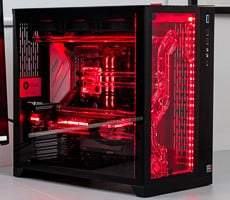Area-51 R5: Software, Configuration, and Overclocking
The Command Center is where users can take the helm to make this ship their own. From the home page, users can apply a custom AlienFX theme or specific performance profile either on a global level or on a per-game basis. The Command Center can automatically scan the system to compile a list of all installed titles. One noteworthy subtlety we should point out is that the Command Center pulls color cues from a selected game title and uses them as an application-wide accent.
AlienFX themes apply per-zone lighting to 9 different LED regions or combinations thereof. It allows for a choice of color, pattern, brightness, and cycle frequency. It is very straight-forward and easy method to configure though it does not provide a significant amount of depth.
The Fusion tab provides options to customize performance profiles. This section has some hefty training wheels, but for novice overclockers or users seeking a one-click solution it does the job. The system ships with two overclocking profiles in addition to stock speeds, as well as couple thermal and power presets – the latter of which mirrors the Windows system power options.
The Core i9-7980XE has a stock boost clock of 4.2GHz with TurboBoost 3.0 allowing two of the eighteen cores to hit 4.4GHz. Overclock Preset 1 displays a target clockspeed of 4.6GHz and Overclock Preset 2 a clockspeed of 4.7GHz, but does not offer any precise details or even whether that’s all-core, single-threaded, or something in between.
We used Intel’s Extreme Tuning Utility to unravel the exact settings used in each profile. Starting with the Stock profile, Intel’s ETU reveals the anticipated 4.2GHz and 4.4GHz targets, using Core 4 and Core 16 to hit the latter target. Turbo Boost is capped at 165W for sustained workloads with one second windows up to 206W permitted. Upon closer inspection, we see the permitted clock speeds taper off depending on the number of active cores, with a full 18-Core load capping out at 3.4GHz. This level of throttling can potentially hamper gameplay when streaming, rendering, and other activities are firing off additional cores, but it won't likely impact the overall experience with so many resources at play in such a powerful processor.
Overclock Preset 2 follows the same path, keeping 16 cores at 4.2GHz and raising the two fastest cores to 4.7GHz. Turbo Boost TDP limits are also increased by another 10W to 240W and 250W, respectively, while keeping the same unrestricted clock speeds regardless of active core counts. In our opinion, there is not much reason to choose Overclock Preset 1 when Overclock Preset 2 exists – but maybe someone somewhere wants a slight power savings while retaining unthrottled cores.
Users can also create their own overclocking profile in the Command Center, but circling back to our training wheels remark, we find the clock speeds limited to 4.7GHz. Unless a user really wants to customize their voltages here or configure a less-extreme overclock, there is not much reason to build a custom profile.
Users who want the absolute most out of the system will abandon the Fusion performance profiles altogether – except maybe as a starting point. Even beyond the processor, the Command Center overclocking profiles do not apply to the GPUs. Instead, we recommend advanced users stick to Intel’s ETU and favorite third-party GPU overclocking software. We will refrain from straying into performance numbers for custom overclocking, but will tease that we were able to hit a stable 4.7GHz all-core overclock in this system. We could probably hit higher with additional tweaking to mitigate thermal constraints during sustained loads.
With strict regards to this system, however, we ran all our benchmarks with the Stock and Overclock 2 (4.7GHz) Presets. These are the performance numbers any user should be working with out-of-the box and higher overclocks are always subject to the silicon lottery.
We will also quickly note that SLI was not enabled at first boot, so be sure to check your graphics configuration as a part of your setup process.
Before we move on to benchmarks, however, Alienware sent one other goody by…












